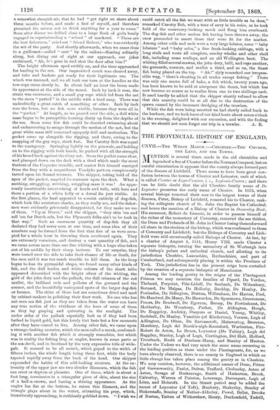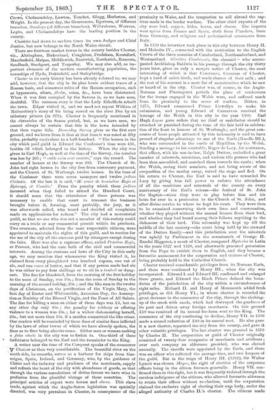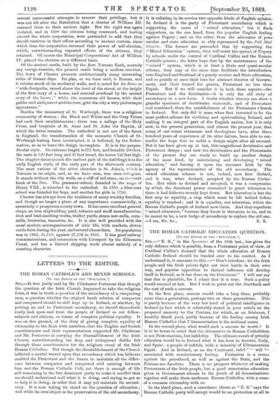THE PROVINCIAL HISTORY OF ENGLAND.
CXVIL-THE WELSH MARCH :-CHESHIRE.-THE CHURCH, THE LAND, AND THE TOWNS.
TENTION is several times made in the old chronicles and .1.11 legends of a See of Chester before theN orman Conquest, but on careful examination it appears that the county always formed part of the diocese of Lichfield. There seems to have been great con- fusion between the towns of Chester and Leicester, each of which is called Ceaster or Lega-Ceaster, i. e., Legionis-Castra ; and there can be little doubt that the old Cheshire family name of De Leycester preserves the early name of Chester. In 1075, when several bishops removed their sees to the largest towns of their dioceses, Peter, Bishop of Lichfield, removed his to Chester, mak- ing the collegiate church of St. John the Baptist his Cathedral. and hence the mention of a Bishop of Chester in Domesday Book. His successor, Robert de Limesie, in order to possess himself of the riches of the monastery of Coventry, removed the see thither, the Dean and Prebends of St. John in Chester losing thenceforward all share in the election of the bishop, which was confirmed to those of Coventry and Lichfield; but the Bishops of Coventry and Lich- field were still occasionally called Bishops of Chester. At last, by a charter of August 4, 1541, Henry VIII. made Chester a separate bishopric, turning the monastery of St. Werburgh into the bishop's palace and cathedral church, and allotting to its jurisdiction Cheshire, Lancashire, Rutlandshire, and part of Cumberland, and subsequently placing it within the Province of York. This jurisdiction has in the present reign been curtailed by the creation of a separate bishopric of Manchester.
Among the leading gentry in the reigns of the Plantagenet Princes we may mention the families of Pipard, De Verdon, Thebaud, Perpoint, Fitz-Lidulf, De Sonbach, De Wibenbury, Bernerd, De* Malpas, De Hellesby, Buckley, De Huxley, De Penlesdon, De Sidington, Dutton, Wilbraham, De Hatton, Pool, De Haselwel, De Massy, De Hawarden, De Spurstowe, Grosvenour, Praers, De Bradwell, De Egerton, Bressy, De Fowleshurst, De M.obberley, De Wrenbury, Parker, De Aldington, Hough, De Ruggeley, Audeley, Danyers or Daniel, Young, Whitley, Scolehall, De Manley, Venables (of Kinderton), Vernon, Legh of Adlington, De Olton, De Ravenscroft, Mainwaring, Brereton, Merebury, Legh del Booth's-nigh-Knotsford, Warburton, Fitz- Robert de Aston, Le Bruen, Leycester (De Tabley), Legh del Baggiley, Stanley, Legh of Legh, Carrington, Del Holt, Holford, Troutback, Booth of Dunham-May, and Stanley of Hooton. Under the Tudors we find very much the same name recurring in the leading position as those under the Plantagenets, for, as we have already observed, there is no county in England in which so little change has taken place among the gentry as in Cheshire. We may mention, however, the additional names of Done, Fitton (of Gawesworth), Paulet, Delves, Trafford, Cholmeley, Aston of Aston, Savage of Rocksavage, Smith of Hatherton, Brook, Calverley, Warren of Pointon, Leversage, Davenport, Legh of Lime, and Holcrof t. In the Stuart period may be added the names of Leycester (of Toft), Banbury, Shakerley, Stanley of Bickerstaffe, Stanley of Nether-Alderley, Powel, Bellot, Brooks of Norton, Tatton of Withershaw, Henry, Duckenfield, Todrill,
Crewe, Cholmondeley, Lawton, Touchet, Glegg, Harleston, and Wright. In the present day, the Grosvenors, Egertons, of different branches, Stanleys (of different branches), Wilbrahams, Warrens, Leghs, and Cholmondeleys have the leading position in the county.
Cheshire had down to modern times its own Judges and Chief Justice, but now belongs to the North Wales circuit.
There are fourteen market towns in the county besides Chester, viz., Altringham, Birkenhead, Congleton; Frodsham, Knutsford, Macclesfield, Malpas, Middlewich, Nantwich, Northwich, Runcorn, Sandbach, Stockport, and Tarporley. We may also add, as im- portant elements of the modern manufacturing population, the townships of Hyde, Dukinfield, and Staleybridge.
Chester in its early history has been already referred to; we may add, however, that the city in its plan bears evident traces of a Roman basis, and numerous relics of the Roman occupation, such as hypocausts, altars, fibake, coins, &c., have been disinterred. When it was first occupied by the Saxons is, as we have seen, doubtful. The common story is that the Lady Ethelfleda rebuilt the town. Edgar visited it, and we need not repeat William of Malmesbury's story of his being rowed on the river Dee by six tributary princes (in 973). Chester is frequently mentioned in the chronicles of the Saxon period, but, as we have seen, we cannot always be certain that this is the town intended by that then vague title. Domesday Survey gives us the first sure ground, and we learn from it that at that time it was rated at fifty hides, probably equivalent to a half-hundred. "The houses in the city which paid guild in Edward the Confessor's time were 431, besides 56 which belonged to the bishop. When the city was given to Earl Hugh, as well at the time of the Survey, the number was less by 205; " valde enim erat vastata," says the record. The number of houses at the Survey was 282. The Church of St. John had eight houses in the city free from customary payment, and the Church of St. Werburgh twelve houses. In the time of the Confessor there were seven moneyers and twelve judices Civitatis. Of the last it is said, 'Hi erant de hontinibus Regis et Episcopi, et Comitis.' From the penalty which these judices incurred when they failed to attend the Hundred Court, it should seem that the attendance of these persons was necessary to enable that court to trausact the business brought before it, forming, most probably, the jury, as it was afterwards called, who heard and decided all complaints made on applications for redress." The city had a mereatorial guild, so that no one who was not a member of this society could carry on a trade or any commercial pursuit within its precincts. Two overseers, selected from the most respectable citizens, were appointed to maintain the rights of this guild, and to receive for the use of the city all the customs paid by strangers except during the fairs. Here was also a supreme officer, called Prwsitus Regis, or Provost, who had the care both of the civil and commercial interests. Among the customs and laws of the City in this early age, we may mention that whensoever the King visited it, he claimed from every ploughherd two hundred capons, one vat of ale, and one rusca of butter, and that if any person made bad ale he was either to pay four shillings or to sit in a tumbril or dung- cart. The fine for bloodshed, from the morning of the first holiday to the noon of Sunday, was 10s.; from the noon of Sunday to the morning of the second holiday, 20s.; and the like sum in the twelve days of Christmas, on the purification of the Virgin Mary, the first day of Easter and Whitsuntide, Ascension Day, the Assump- tion or Nativity of the Blessed Virgin, and the Feast of All Saints. The fine for killing a man on either of these days was £4, but on any other day only 40s.; the penalty for robbery or offering violence to a woman was 40s.; for a widow dishonouring herself, 20s., but not more than 10s. if a maiden committed the like crime. Our readers will be reminded by these fines of similar fines inflicted by the laws of other towns of which we have already spoken, the fines as to fires being also the same. Either man or woman making a false abode in the city was to forfeit Is. One-third of these forfeitures belonged to the Earl and the remainder to the King.
A writer near the time of the Conquest speaks of the commerce
, Chester a then very considerable. The beautiful river on the
. . south side, he remarks, serves as a harbour for ships from Gas- coigne, Spain, Ireland, and Germany, who, by the guidance of Christ and the industry and prudence of the merchants, supply and refresh the heart of the city with abundance of goods, so that through the various consolations of divine favour we have wine in profusion from the plentiful vintage of these countries. The principal articles of export were horses and slaves. This slave trade, against which the Anglo-Saxon legislation was specially directed, was very prevalent in Cheater, in consequence of the proximity to Wales, and the temptation to sell abroad the cap- tives made in the border warfare. The other chief exports of the city were lead, copper, hides, horns, and cheese. The imports were spices from France and Spain, cloth from Flanders, linen from Germany, and. religious and ecclesiastical ornaments from Italy.
In 1159 the interview took place in this city between Henry II. and Malcolm IV., connected with the restitution to the English Crown of the three counties of Cumberland, Northumberland, and Westmorland. Giraldus Canibrensis, the chronicl-- who accom- panied Archbishop Baldwin in his passage through the city thirty years later, gives us only a meagre notice of Chester, the most interesting of which is that Constance, Countess of Cheater, kept a herd of mulch hinds, and made cheeses of their milk ; and the rest of his account is a mere list of monstrosities which he saw or heard of in the city. Chester was, of course, in the Anglo- Norman and Plantagenet periods the place of rendezvous for the troops engaged in the Welsh wars, and suffered much from its proximity to the scene of warfare. Hither, in 1275, Edward summoned Prince Llewellyn to make his submission, and young Edward of Carnarvon received the homage of the Welsh in this city in the year 1300. Earl Hugh Lupus gave orders that no thief or malefactor should be attached or punished during the time of the fair held in celebra- tion of the feast in honour of St. Werburgh ; and the great con- course of loose people attracted by this indemnity is said to have proved of singular advantage to one of the Earls (Randle HI.), who was surrounded in the castle of Rhyddlan by the Welsh. Sending a message to his constable, Roger de Lacy, for assistance, that officer, with his son-in-law, Ralph Dutton, embodied a great number of minstrels, musicians, and various idle persons who had been thus assembled, and marched them towards the castle ; when the Welsh, seeing their numbers, and not being aware of the conposition of the motley array, raised the siege and fled. On his return to Chester, the Earl is said to have rewarded De Lacy by giving him full power to enforce the attendance of all the musicians and minstrels of the county on every anniversary of the Earl's release—the festival of St. John the Baptist—when they were to play before him and his heirs for ever in a procession to the Church of St. John, and after divine service to where he kept his court. They were then to be examined concerning their own lives and conversation, whether they played without the annual licence from their lord, and whether they had heard among their fellows anything to the dishonour of their lord. This solemnity was kept up till the middle of the last century—the court being held by the steward of the Dutton family—and this jurisdiction over the minstrels was upheld by Parliament in the seventeenth of George II. Randal Higgenet, a monk of Chester, composed Mysteries in Latin in the years 1327 and 1328, and afterwards procured permission from the Pope to exhibit them in English, and they became a favourite amusement for the corporation and citizens of Chester, being probably held in the Cathedral Church.
Chester received considerable privileges from its Norman Earls, and these were 'confirmed by Henry III., when the city was incorporated. Edward I. and Edward III. confirmed and enlarged these grants, and Edward the Black Prince defined the boun- daries of the jurisdiction of the city within a circumference of eight miles. Richard IL and Henry of Monmouth added fresh privileges, as did Henry VI., in whose charter is recorded the great decrease in the commerce of the city, through the choking- up of the creek with sands, which had destroyed the goodness of its port and driven away foreign merchants. On this ground £10 was remitted of its annual fee-farm rent to the King. The commerce of the city continuing to decline, Henry VII. in 1506 made a second reduction of £80 in its annual rent. He also gave it a new charter, separated the city from the county, and gave it other valuable privileges. The last charter was granted in 1676 by Charles II. The corporation or guild of Chester originally consisted of twenty-four companies of merchants and artificers; over each company an alderman presided, who was elected annually. The sheriffs were appointed by the Earls, and there was an officer who collected the murage dues, and two keepers of the guild. But in the reign of Henry III. (1242), Sir Walter Lynett was chosen Mayor, the right of election of the corporate officers being in the citizen freemen generally. Henry VII. con- firmed them in this right, but it was frequently violated through the careless indulgence of the citizens, who allowed favourite aldermen to retain their offices without re-election, until the corporation claimed the exclusive right of electing their ow body, under the alleged authority of Charles iI.'s charter. The citizens made
several unsuccessful attempts to recover their privilege, but it was not till after the Revolution that a charter of William ILL restored them to their ancient right. But the right was again violated, and in 1698 the citizens being convened, and having elected the whole corporation, were persuaded to add that they should continue in their offices according to ancient custom, since which time the corporation resumed their power of self-election, which, notwithstanding repeated efforts of the citizens, they retained. Of course the Municipal Corporations' Act of William W. placed the election on a different basis.
Of the ancient castle, built by the first Norman Earls, scarcely any vestige remains, the present castle being a modern erection. The town of Chester presents architecturally many interesting relics of former days. Its plan, as we have said, is Roman, and it retains much of its medimval walls, and is noted for its Rows or "wide footpaths, raised above the level of the street, at the height of the first story of a house, and covered overhead by the second story of the house ;" while the numerous old houses, with their gables and antiquated architecture, give the city a very picturesque appearance."
Besides the monastery of St. Werburgh, there was a religious community of women ; the Black and White and the Grey Friars had each their establishments ; there was a college of the Holy Cross, and hospitals of St. Anne and St. John the Baptist, of which the latter remains. The cathedral is not one of the finest in England, the transformation of the monastic Church of St. Werburgh having been interrupted, it is believed, by the Refor- mation, so as to leave the design incomplete. It is in the perpen- dicular style. Its extreme length is 375 feet, and breadth 200 feet, the nave is 120 feet long and 41 feet broad, the tower 127 feet high. The chapter-house (much the earliest part of the building) is in the early English style, of the early part of the thirteenth century. The most curious of the other churches is St. John's, which is Norman in its origin, and, as we have seen, was once collegiate. It stands without the city walls, on a cliff of red stone, on the north bank.of the Dee. The grammar-school, founded in the reign of
Henry is attached to the cathedral. In 1700, a blue-coat school was founded for boys, and another for girls in 1750.
Chester has always been the residence of many wealthy families, and though no longer a place of any importance commercially, is essentially a prosperous county town. It has some excellent general shops, an iron shipbuilding yard, tobacco and snuff manufactories, shot and lead-smelting works, timber yards, steam saw-mills, corn- mills, breweries, tanneries, &c. It is also well provided with the usual modern accompaniments of civic life, with markets, eleven cattle fairs during the year, and several cheese fairs. Its population was in 1861, 31,110, against 27,756 in 1851. It has good railway communications, and connection with Liverpool by the Ellesmere Canal, and has a limited shipping trade almost entirely of a coasting character.
































 Previous page
Previous page